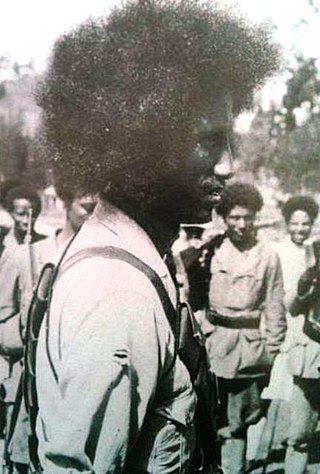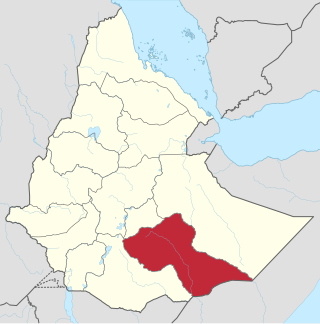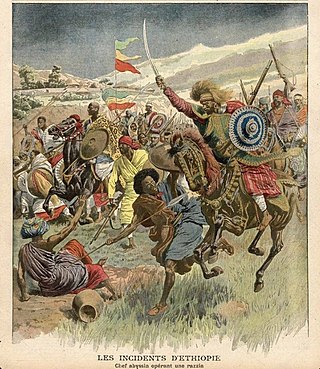
Tewodros II was Emperor of Ethiopia from 1855 until his death in 1868. His rule is often placed as the beginning of modern Ethiopia and brought an end to the decentralized Zemene Mesafint.

Sidamo Province was a province in the southern part of Ethiopia, with its capital city at Irgalem, and after 1978 at Awasa. It was named after an ethnic group native to southern Ethiopia, called the Sidama, who are located in the south-central part of the country.

Sarsa Dengel, also known as Sarsa the Great, was Emperor of Ethiopia, and a member of the Solomonic dynasty. His throne name was Malak Sagad I.

Susenyos I, also known as Susenyos the Catholic, was Emperor of Ethiopia from 1607 to 1632, and a member of the Solomonic dynasty. His throne names were Seltan Sagad and Malak Sagad III.
The Battle of Debre Abbay, also known as the Battle of Mai Islami, was a conflict between Ras Marye of Yejju, regent of the Emperor of Ethiopia, and his rival from Tigray, Dejazmach Sabagadis of Agame. Although Ras Marye lost his life in the battle, Dejazmach Sabagadis was defeated and executed by Ras Marye's followers after surrendering.

Illubabor was a province in the south-western part of Ethiopia, along the border with Sudan. The name Illubabor is said to come from two Oromo words, "Illu" and "Abba Bor(a)". "Illu" is a name of a clan, and "Abba Bor" was the horse name of Chali Shone, who founded the ruling family of the area when it was conquered by Shewa; hence IlluAbabor means the Illu belonging to Ababor(a).

General Waqo Gutu Usu was an Ethiopian revolutionary and leader of one of the earlier Oromo resistance fighter movements; the Bale Revolt, which in the 1960s had fought against the feudalistic system in place in the Ethiopian Empire. He was elected chairman of the United Liberation Forces of Oromia in 2000. In 2006, Gutu died in a Nairobi hospital, survived by 20 sons and 17 daughters.

Darge Sahle Selassie Horse name Abba Gersa was a 19th-century Ethiopian nobleman, provincial governor, general and a trusted councillor of his nephew Emperor Menelik II.

Onesimos Nesib was a native Oromo scholar who converted to Lutheran Christianity and translated the Christian Bible into Oromo. His parents named him Hika as a baby, meaning "Translator"; he took the name "Onesimus", after the Biblical character, upon converting to Christianity.

The Battle of Embabo was fought 6 June 1882, between the Shewan forces of Negus Menelik and the Gojjame forces of Negus Tekle Haymanot. The forces fought to gain control over the Oromo areas south of the Gibe River. The Gojjame forces under Tekle Haymanot were defeated. This is one of the three battles which Donald Donham lists that led to Shewan supremacy over the rest of Ethiopia.
RasGobena Dache was an Ethiopian military commander for and during Menelik II's reign. An ethnic Oromo, he is known for campaigning against Oromo territory to incorporate more lands into the Ethiopian Empire in the late 19th century.

The Mugar River is a north-flowing tributary of the Abay River in central Ethiopia, which is notable for its deep gorge. Its confluence with the Abay is at: 9°55′07″N37°55′50″E. Tributaries of the Muger include the Labbu. The Muger has a drainage area of about 8,188 square kilometers. It was bounded by the historical Endagabatan province.
The Battle of Anchem was a battle fought between two factions of the Royal family in the Ethiopian Empire. The battle was fought to determine who would rule the empire, Empress Zewditu or King (Negus) Tafari Makonnen.
Gugsa Wale's rebellion of 1930 was a rebellion raised by Ras Gugsa Wale and by supporters of Empress Zewditu to rid her of the Crown Prince and heir apparent, Negus Tafari Makonnen. With Tafari gone, Zewditu would be the sole claimant to succession as the ruler of the Ethiopian Empire. As the husband of Empress Zewditu, Gugsa Wale expected to become Emperor.

Belay Zeleke was an Ethiopian military commander who led the Arbegnoch resistance movement in Gojjam against the Fascist Italians during the Italian occupation of Ethiopia from 1936 to 1941. He emerged as a brigand leader after his five-year struggle against Italian rule in Ethiopia.

The Bale revolt, also known as the Bale Peasant Movement, was an insurgency that took place in the 1960s in the southeastern Ethiopian province of Bale among the local Oromo and Somali populations. The revolt targeted the feudalist system in place during the Ethiopian Empire and was rooted in ethnic and religious grievances.

Wube Haile Maryam of Semien, (1799–1867), also called by his title Dejazmach Wube, Webé; his name is also given in European sources as ‘‘Ubie’’, was one of the major figures of 19th century Ethiopia, during the closing decades of the Zemene Mesafint a period of regional lords vying for power, prestige and territory amid a weakened authority of the emperors.

Menelik's Invasions, also known as the Agar Maqnat were a series of wars and conquests carried out by Menelik II of Shewa to expand the Ethiopian Empire.
Endagabatan also known as Enda Gabtan, Anda Gabtan, or Endagabton was a historical province of Ethiopia. Located north west of the old Fatagar region, bounded by Mugar, Gudar as well as Abay rivers. The region is in modern west Shewa province.
Asmadin was a Malassay of the Adal Sultanate and later Garad (governor) in Abyssinia. He remained in Ethiopia as governor of Wej province after Adal's defeat and subsequent military withdrawal from Abyssinian territory. Asmadin had a great deal of influence in Abyssinia as he is known for assisting the imperial forces of Emperor Sarsa Dengel at the Battle of Endagabatan and the Battle of Hadiya. A gate is named after him in the city of Harar called Asmadin Bari.













